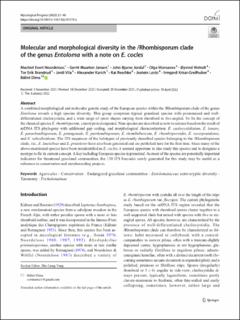| dc.contributor.author | Noordeloos, Machiel Evert | |
| dc.contributor.author | Jansen, Gerrit Maarten | |
| dc.contributor.author | Jordal, John Bjarne | |
| dc.contributor.author | Morozova, Olga | |
| dc.contributor.author | Weholt, Øyvind | |
| dc.contributor.author | Brandrud, Tor Erik | |
| dc.contributor.author | Vila, Jordi | |
| dc.contributor.author | Karich, Alexander | |
| dc.contributor.author | Reschke, Kai | |
| dc.contributor.author | Lorås, Jostein Arve | |
| dc.contributor.author | Krisai-Greilhuber, Irmgard | |
| dc.contributor.author | Dima, Bálint | |
| dc.date.accessioned | 2022-06-23T12:34:50Z | |
| dc.date.available | 2022-06-23T12:34:50Z | |
| dc.date.created | 2022-04-20T11:01:38Z | |
| dc.date.issued | 2022 | |
| dc.identifier.citation | Noordeloos, M. E., Jansen, G. M., Jordal, J. B., Morozova, O., Weholt, Ø., Brandrud, T. E., Vila, J., Karich, A., Reschke, K., Lorås, J. A., Krisai-Greilhuber, I. & Dima, B. (2022). Molecular and morphological diversity in the /Rhombisporum clade of the genus Entoloma with a note on E. cocles. Mycological Progress, 21: 48. doi: | en_US |
| dc.identifier.issn | 1861-8952 | |
| dc.identifier.uri | https://hdl.handle.net/11250/3000269 | |
| dc.description.abstract | A combined morphological and molecular genetic study of the European species within the /Rhombisporum clade of the genus Entoloma reveals a high species diversity. This group comprises typical grassland species with pronounced and welldifferentiated cheilocystidia, and a wide range of spore shapes varying from rhomboid to five-angled. To fix the concept of the classical species E. rhombisporum, a neotype is designated. Nine species are described as new to science based on the result of nrDNA ITS phylogeny with additional gap coding, and morphological characterization: E. caulocystidiatum, E. lunare, E. pararhombisporum, E. pentagonale, E. perrhombisporum, E. rhombiibericum, E. rhombisporoides, E. sororpratulense, and E. subcuboideum. The ITS sequences of the holotypes of previously described species belonging to the /Rhombisporum clade, viz., E. laurisilvae and E. pratulense have also been generated and are published here for the first time. Since many of the above-mentioned species have been misidentified as E. cocles, it seemed opportune to also study this species and to designate a neotype to fix its current concept. A key including European species is presented. As most of the species are potentially important indicators for threatened grassland communities, the 130 ITS barcodes newly generated for this study may be useful as a reference in conservation and metabarcoding projects. Agaricales . Conservation . Endangered grassland communities . Entolomataceae semi-cryptic diversity . Taxonomy . Tricholomatinae | en_US |
| dc.language.iso | eng | en_US |
| dc.publisher | Springer | en_US |
| dc.rights | Navngivelse 4.0 Internasjonal | * |
| dc.rights.uri | http://creativecommons.org/licenses/by/4.0/deed.no | * |
| dc.title | Molecular and morphological diversity in the /Rhombisporum clade of the genus Entoloma with a note on E. cocles | en_US |
| dc.type | Peer reviewed | en_US |
| dc.type | Journal article | en_US |
| dc.description.version | publishedVersion | en_US |
| dc.rights.holder | © 2022 The Author(s) | en_US |
| dc.subject.nsi | VDP::Matematikk og Naturvitenskap: 400::Zoologiske og botaniske fag: 480::Systematisk botanikk: 493 | en_US |
| dc.source.pagenumber | 32 | en_US |
| dc.source.volume | 21 | en_US |
| dc.source.journal | Mycological Progress | en_US |
| dc.identifier.doi | 10.1007/s11557-022-01779-z | |
| dc.identifier.cristin | 2017810 | |
| dc.source.articlenumber | 48 | en_US |

